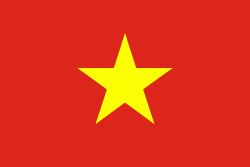Điện Biên Phủ (Dien Bien Phu)
Điện Biên Phủ lies in Mường Thanh Valley, a 20 km) long and 6 km wide basin sometimes described as "heart-shaped." It is on the western edge of Điện Biên Province, of which it is the capital, and is only about 10 km from the border with Laos.
Until the creation of the province in 2004, Điện Biên Phủ was part of Lai Châu Province. The Vietnamese government elevated Điện Biên Phủ to town status in 1992, and to city status in 2003.
Statistics on Điện Biên Phủ's population vary depending on definitions—figures are generally between 70,000 and 125,000. The city is growing quickly and was projected to have a population of 150,000 by 2020.
According to statistics from the government, as of 2019, the city had a population of 80,366 people, covering an area of 308.18 km2.
Map - Điện Biên Phủ (Dien Bien Phu)
Map
Country - Vietnam
 |
 |
| Flag of Vietnam | |
Vietnam was inhabited by the Paleolithic age, with states established in the first millennium BC on the Red River Delta in modern-day northern Vietnam. The Han dynasty annexed Northern and Central Vietnam under Chinese rule from 111 BC, until the first dynasty emerged in 939. Successive monarchical dynasties absorbed Chinese influences through Confucianism and Buddhism, and expanded southward to the Mekong Delta, conquering Champa. The Nguyễn—the last imperial dynasty—surrendered to France in 1883. Following the August Revolution, the nationalist Viet Minh under the leadership of communist revolutionary Ho Chi Minh proclaimed independence from France in 1945.
Currency / Language
| ISO | Currency | Symbol | Significant figures |
|---|---|---|---|
| VND | Vietnamese đồng | ₫ | 0 |
| ISO | Language |
|---|---|
| KM | Central Khmer language |
| ZH | Chinese language |
| EN | English language |
| FR | French language |
| VI | Vietnamese language |















